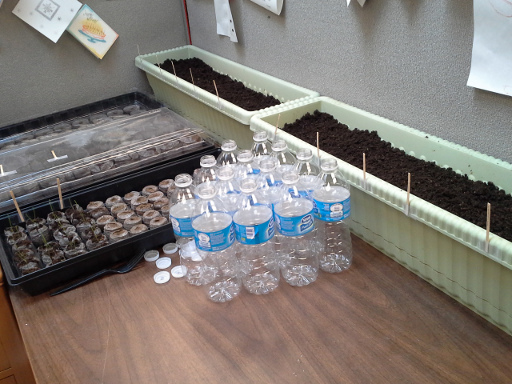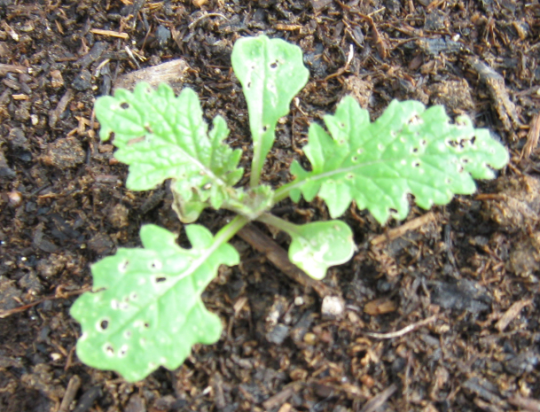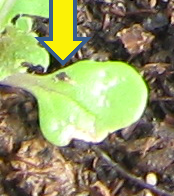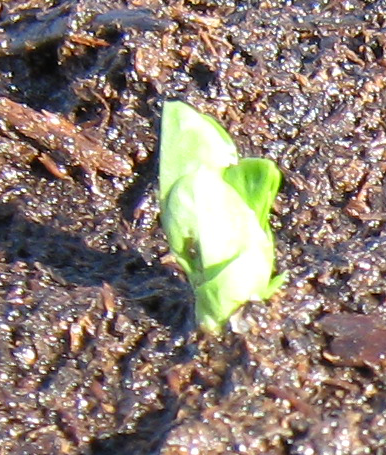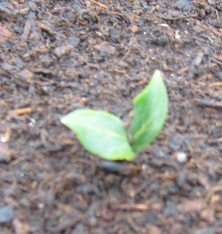Yesterday brought the first real harvest from my little garden. I was so pleased!
We got to try some of both kinds of radish, the spinach, and some from each patch of lettuce, though only two of the four varieties in the mesclun mix were large enough to cut: the mustard and the arugula. The “red looseleaf” is still very small, and I’m not sure I see any endive growing in there at all, yet. It wasn’t quite enough to make a salad out of by itself, but it did turn out to be about a dollar’s worth of lettuces/spinach ($2, if I check organic prices) and about another dollar’s worth of radishes. I ended up spending an additional $22 on bamboo canes to build trellises for the peas and cucumbers, which will be another post, but it was nice to start seeing some return on the investment!
The radishes are still a little on the small side, but they were certainly large enough to eat. I left some of the smallest mature radishes to see how large they will get with a little more time. The French Breakfast were tender and mild with good flavor, while the German Giant had a satisfying crunch and brought some late heat to their fresh crispness. While I intend to purchase my seeds from a different source for next year, I would grow either of these varieties again. The Burpee seeds have performed pretty well, with about 40% of my first planting sprouting, despite a couple of nights of freezing-or-below temperatures, and 85% of my second planting and 100% of my third planting of each variety sprouting. I lost four sprouts in total to some kind of damage, which may have been insects or the wrong amount of water at a critical time rather than any defect in the plants.

German Giant on the left, French breakfast on the right.
This evening, I’ll be mixing up some more soil in a large bucket, so I can have it on hand to patch holes caused by harvesting. Once I add some more soil, I’ll plant more radishes in the empty spots, which should be ready by the end of August. The stake visible here is part of my new trellis.
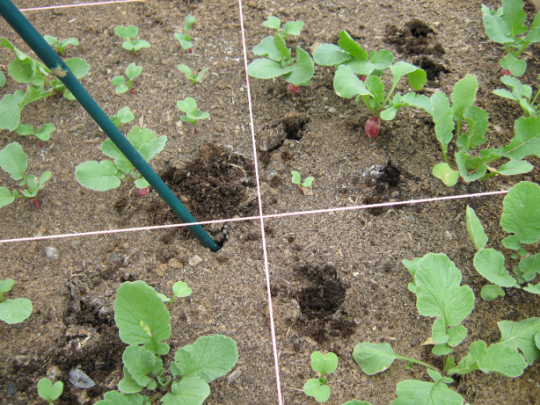
Empty spaces, ready for a handful of good soil and a few more radish seeds.
A few new spinach sprouts are visible around these larger plants, which were lightly trimmed of their largest one or two leaves per plant. The other patch of spinach has about three times as many plants, since the first planting of spinach took so long to come up, and I gave that patch a second planting about three days before most of the first planting started popping through the surface. I did not second-plant the square shown below until a later date, and only planted in the empty spots. I need to plant a few more seeds in here. All in all, I got about a third of a cup of spinach. These seeds took much longer to sprout than advertised, and I’d say about 70% of the seeds planted have sprouted. I have not lost any spinach sprouts once they’ve managed that, however. The leaves are tasty, and the fresh young leaves are not as tough as store-bought spinach, even when comparing to “baby spinach.” I suspect that refrigeration and days of storage are responsible for that effect.
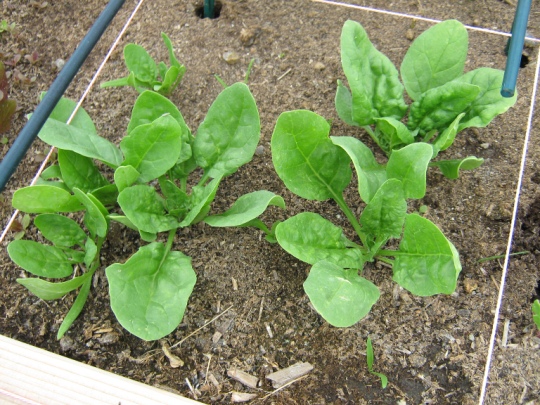
Strong to the finish!
The Rouge d’Hiver is growing quite well. Pictured below is the square with the second planting, though there are several plants from the first planting in the adjacent square. Because this was scatter-planted, I don’t know what the percentage of successful seeds is, but the results of the second planting are quite satisfactory. A third planting has been made in the first square, around the existing plants, and a lot of new sprouts are beginning to get their first true leaves. As you can see to the left, the Rouge d’Hiver seeds were rather migratory, escaping into the peas and the Forellenschluss. These stray plants were pulled entire and the roots cut off, to add to the largest 2-3 leaves taken from most of the plants with at least 6 leaves (many had 10 or more). There was about 2/3 of a cup of this lettuce. I was afraid it would be bitter, as many red lettuces are, but it had a warm and lightly earthy flavor. I would plant this variety again.
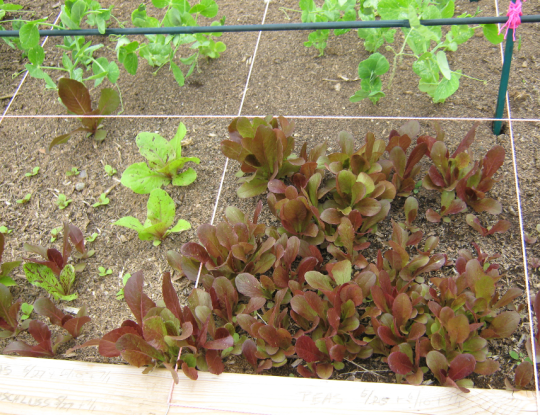
Rouge d’Hiver seems to like the conditions.
Because Forellenschluss eventually forms loose heads, I planted these with spacing in mind. A few seeds apparently blew away as I was planting, and I found a few of these plants outside of their desired locations, as well. Between pulling those and taking 1 leaf from each of the largest plants, I ended up with about a third of a cup of this lettuce. It has a sweet, nutty flavor and a lightly crisp texture. I have never seen this variety in stores, which I have decided is a real shame, since I find most commercially-available romaines to be uninspired and too much rib for the leaf. I plan to use some of these to make lettuce wraps later this summer. I will definitely grow this variety again, which amuses me, since I only bought it originally because it has freckles like me! The seeds had good success, with over 90% of those planted sprouting, and the sprouts having a 100% survival rate.

Freckled faces.
The Salad Bowl lettuce is another variety that develops loose heads, so I again planted it with a bit more spacing in mind. All but one of this second planting square sprouted, and I was able to take 2-3 leaves off the larger plants for a total of about a half cup. It’s sturdy and seems to hold no appeal to vegetarian insects at all, and the flavor is sweet and complex. This variety seems to find its way into commercial mixed salad packages from time to time, but I wish it was available in larger quantities and on its own. This is an excellent lettuce to use as a “base” for salad, and I think it would also be good on sandwiches. I will definitely grow this variety again.

It’s a jump to the left…
Some of the mesclun proved so attractive to the flea beetles that I had to look up what it was composed of. The Burpee site says it’s 20% each of arugula, mustard, red leaf lettuce and endive. I’m not sure how that math works out, but I do know that mustard was one of the recommended “trap crops” to plant in order to keep flea beetles off preferred crops, which explains their fascination. They also seem to be willing to eat the arugula, but the mustard appears to be like candy to them. Still, I managed to get a few leaves of both mustard and arugula, totaling about a third of a cup. (I don’t see any endive in there at all.) the lettuce is all near the center of the section because this was also scatter-planted, and the water washed the seeds into a low spot in the soil. I think I might grow these as separate varieties next year, in order to have more of each. The mustard has a nice kick to it, and the arugula is just bitter enough to provide a nice contrast to the sweeter lettuces. Most of the seeds appear to have been fairly successful, but again, I’m not sure any of the endive made it. The first planting did not sprout well, but the second planting did.
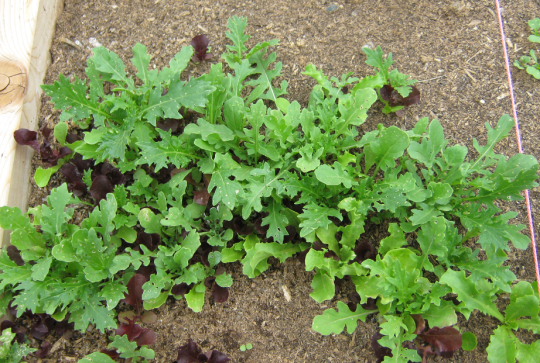
Put your leaves all in.
Here’s the first harvest. The lettuces are all stuck flat together from being washed, but fluffed up to fill about half that colander after they were dried between layers of paper towel. They all stored well in that stack of damp paper toweling on the counter for about half an hour, until it was time to assemble the salad. I think the next time I pull root vegetables, though, I’ll take the colander out and give them a shower from the hose before I bring them in…there was an alarming amount of dirt in that pie tin before I was through, even though I tried to brush most of it back into the garden!

Time to wash up for supper!
All in all, this was easily enough success to keep me happy puttering around in the garden. I’m already planning improvements and additions for next year, when I hope to get some zucchini, cabbage, onions and beans, and maybe some basic herbs, like chives, garlic and parsley.
